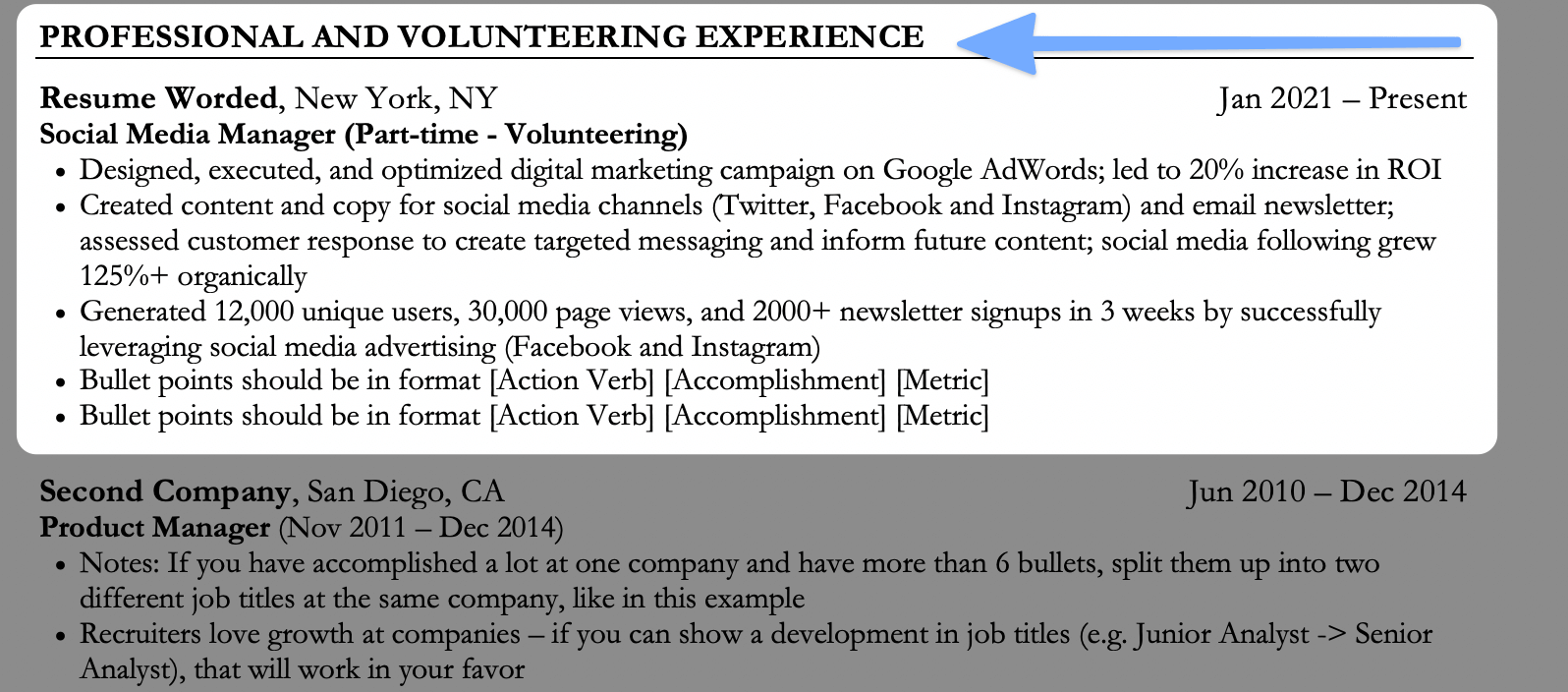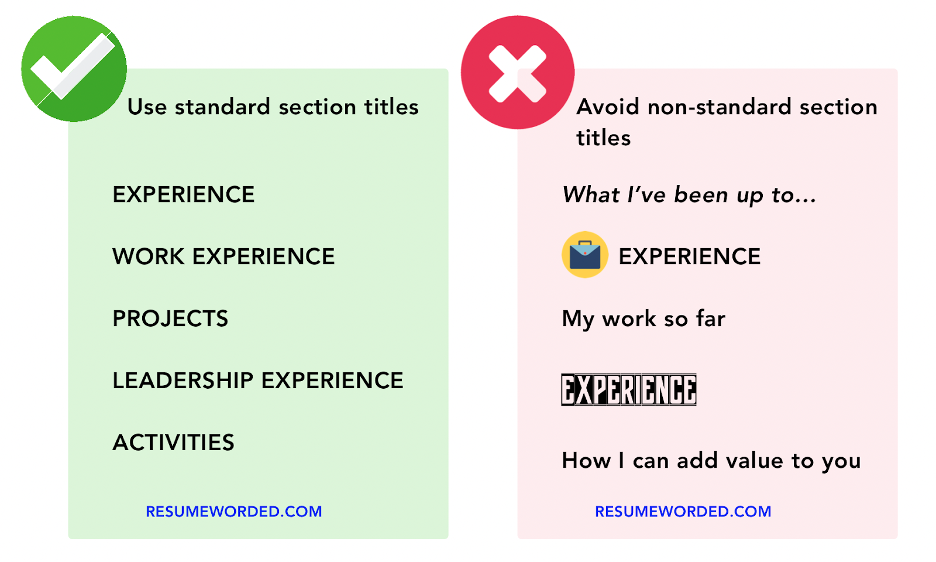No matter whether this is your first, fifth, or fifteenth time in the job market, the first step to any successful job search starts with a strong resume. But with so many different potential resume sections — hard skills, qualifications, work experience, summary — it can be hard to know which sections you need and what titles to use to best showcase your skills.
Proper section titles not only enhance the readability of your resume but also ensure it makes it past ATS, so it's an important thing to get right.
In this article, we’ll explain how best to title the different sections of your resume so each part can stand out on its own. We'll discuss what each resume section should contain, when you need to include it and when you don’t, optional additional sections for your resume depending on your experience and industry, and how best to structure your resume to put your most professional foot forward.
So, let’s get to it.
Resume section titles: A quick guide
There's no single right (or wrong) way to title and structure your resume, but there are a few best practices you can stick to:
- Stick to standard titles: Avoid creative or vague titles like “My Work in a Nutshell” or “What I’ve Been Up To.” Instead, use clear, professional titles such as “Experience,” “Education,” or “Skills.”
- Font and format matter: Choose legible, professional fonts and steer clear of fanciful or downloaded fonts. Consistent formatting, such as bullet points and headers, ensures a clean, professional look.
- Simplicity is key: Keep your section titles straightforward and descriptive. Avoid ambiguity to help hiring managers and ATS find what they're looking for quickly.
- Avoid graphics: While graphics can be visually appealing, they often don't translate well through ATS.
- Customize sections as needed: Include additional sections like “Certifications,” “Publications,” or “Projects” if they add value to your resume and are relevant to your field, but avoid overloading your resume with unnecessary information.
- Merge sections if possible: If sections like “Volunteering” and “Work Experience” contain similar types of content, consider merging them into one cohesive section like “Professional Experience.”
Why do resume section titles matter?
Because recruiters and hiring managers begin by skimming your resume, well-written section titles and headings can make a big difference in helping them identify the information they need quickly. The less time they spend on figuring out where everything is, the more energy they’ll have to read the important content within each section.
Resume titles are also crucial for getting past modern Applicant Tracking Systems(ATS), which filter candidates based on relevant experience and keywords. Poorly titled sections risk being overlooked both by ATS, potentially leading to early rejection from the automatic software.
Essential resume sections and titles
Each resume section title describes a major component of your professional history — be it education, work experience, skills, or awards. What particular sections you decide to showcase on your resume will depend on your industry, level of seniority, and the position that you’re applying for, but there are a few key sections all resumes should include.
Resume header
Your personal information should always be the first thing on your resume. This shouldn't take up a lot of space — 1-2 lines is all you need.
What to include: Your first and last name, email address, contact number, and general location (not your full street address). You can include a LinkedIn or portfolio link if appropriate.
What not to include: Your age, date of birth, photo, or other personal information.
Work Experience
This is the single most important section of your resume and the one hiring managers care about the most. Relevant work experience, including traditional roles, freelance, contract, and remote work, should be prioritized here, followed by experience in other roles or industries. If you’re a student or don’t have any traditional work experience, you can use this section to list internships, extracurriculars, or volunteering experience.
What to include: Any job you've held in the past ~10 years that's relevant to the position you're applying for. If you’ve been working as a freelancer or participating in the gig economy, include this experience by listing the type of work, along with a general timeframe and a summary of your achievements. List jobs in reverse chronological order (most recent first), and include your job title, employer, location, dates of employment, and 3-6 bullet points showcasing your most relevant accomplishments.
What not to include: Feel free to leave off jobs you only held for a very short time (less than six months) or where you can't list any significant achievements.
What to name it: Experience, Work Experience, Professional Experience or Employment. For freelance or gig work, if listed separately, use titles such as Freelance Experience, Independent Work, or Contract Roles.
Education
The education section of your resume becomes less important the longer you've been in the workforce, but most hiring managers will still expect to see it. If you're a recent graduate, this can be a longer section at the top of your resume, but in all other cases, keep it to a few lines underneath your work experience.
What to include: The name and location of the school you attended and the degree(s) you attained. If you have multiple degrees, list your most recent or advanced degree first. You can also include your major (and any relevant minors), GPA (if above 3.5), and academic awards, keeping in mind that the longer you've been out of school, the less detailed this section should be.
What not to include: Your high school information, unless you're still in high school. You can also leave off your date of graduation, especially if you're worried about age discrimination.
What to name it: Education is the most common, but you can also use Professional Training, Education and Training, Educational Qualifications, or Relevant Training.
Using the right titles for your resume sections not only helps recruiters quickly understand what’s in each of your sections, it’s also a good way to help your resume get past ATS. Once you’re done writing your resume, upload it to the tool below to find out if your sections are titled correctly. The tool also gives you detailed feedback and suggestions to improve other aspects of your resume.
Optional resume sections and titles
There are other resume sections you can include depending on the experience you have and what you want to prioritize. Keep in mind that you don't want your resume to be too busy — 1-2 pages and no more than 4-5 sections is ideal, so choose additional sections based on what's genuinely relevant and likely to improve your candidacy.
Resume title
You may choose to include a job title at the top of your resume, right below your name. This job title should ideally match the job title of the role you’re submitting your resume for. While this is optional, it’s a quick and easy way to tailor your resume to the job you’re applying for. And, as an added bonus, it’ll ensure the ATS identifies you as a relevant candidate — even in a case where you would have otherwise been sorted out.
What to include: The exact title of the job you're applying for.
What not to include: Anything else.
What to name it: Nothing! This section doesn't need its own heading — simply include it underneath your name and above your contact information.
Resume summary
You can include a resume summary section at the top of your resume, right below your name and contact information. This is optional, but it can be useful in cases where your resume isn't fully self-explanatory, especially for people changing careers.
What to include: A few short sentences about your key skills and experience. In a sense, it’s a highlight of the best parts of your resume, which is in turn a highlight of your most relevant experiences and most impressive accomplishments.
What not to include: Information that isn't directly relevant to the job you're applying for, including personal information.
What to name it: You don’t need to label this section — since it’s at the top of your resume, all recruiters and hiring managers know what that section is. If you’d like to include a title, the best ones to use for this section are Summary or Professional Summary
Skills section
This section lists your relevant skills. Only include hard skills, like a programming language (e.g. Java, C++, Swift, etc.) or software suite (e.g. QuickBooks, Kubernetes, Microsoft Power BI, etc.) that you are familiar with.
What to include: Any hard or technical (that is, objective and provable) skills that you're likely to need in the job you're applying for. If in doubt, check what skills are mentioned in the job description.
What not to include: Don't include soft skills like teamwork, communication, or leadership.
What to name it: Simply title this section “Skills.” If you have different kinds of skills, you can include multiple subheadings, for example Competencies, Technical Software, Languages, or Certifications
Use the tool below to get a list of hard and technical skills you’re likely to need in the job you’re applying for.
Online profiles or portfolios
Including a section on your resume for online professional profiles and portfolios can be a great addition, especially in fields where digital presence and content creation are integral to the role. Providing links to your online profiles allows potential employers to see a more comprehensive view of your skills and experiences and connect with you through these various job boards.
What to include: Links to professional networking profiles (like LinkedIn), personal websites, or digital portfolios that showcase your work. Ensure that these profiles are current, professional, and reflect your skills and experiences relevant to the job you're applying for.
What not to include: Avoid linking to personal social media accounts or any online content that does not contribute to your professional image.
What to name it: “Professional Online Presence,” “Digital Portfolio,” “Online Profiles,” or “Web Portfolio.” Choose a title that best represents the nature of the content you are including.
Projects and extracurricular activities
If you lack extensive work experience in the field you're applying to, including non-work experience — like projects or extracurricular activities — can be a good way to round out your resume and highlight relevant skills.
What to include: Anything that demonstrates relevant skills or experience. List the organization, your role, the dates, and 1-2 accomplishments. If applicable, you can also include a link to a GitHub or portfolio to showcase your work directly.
What not to include: Regular coursework or casual hobbies that aren't directly relevant to the job you're applying for.
What to name it: Projects, University Projects, Activities, or Extracurricular Activities
Volunteer work
If you regularly devote time to an organization, have served on its board, or engage in any kind of unpaid labor, you can list those volunteering engagements here, as you would a job. If you spend significant time volunteering, you can even consider merging this section with your experience section, and mention both compensated and uncompensated work in a single place.
What to include: List your volunteer experience the same way you would paid work experience, including your job title, organization, dates, and accomplishments.
What not to include: Depending on the nature of the organization and the job you're applying for, you may want to consider leaving some kinds of volunteer work (i.e. religious or political volunteer work) off your resume. Use your discretion with this — in some cases, like political nonprofits, this kind of work might actually be a bonus.
What to name it: Volunteering, Volunteer Work, Volunteering Experience, or Community Engagement
Certifications
Most certifications can be included in your education or skills section, but if you have multiple relevant qualifications you want to highlight, it might be worth giving them their own section.
What to include: Certifications that are directly relevant to the job you're applying for, including common industry qualifications or ones that are necessary to perform the job (like medical or legal qualifications).
What not to include: Leave off short courses, seminars, and anything that isn't relevant.
What to name it: Certifications or Professional Certificates. Don’t title this section “Scholastic Achievements,” “Academic Career,” or anything too elaborate. Additionally, don’t use a title like "Educational Experience," which might be incorrectly interpreted as a work experience.
Additional information
Not everything on your resume needs its own section. If you want to include something on your resume but are running low on space, it's okay to combine multiple sections into one or to have a single catch-all "other" section at the bottom.
What to include: Anything that doesn't belong in any other section of your resume. This could include honors and awards, publications, skills, language proficiency, certifications, and volunteer work that don't need their own section.
What not to include: As with anything else on your resume, if it's too personal or not relevant to the job you're applying for, leave it off.
What to name it: Additional Information, Other, Awards, Achievements, Industry Recognition, or Career Highlights

Multiple experience sections
If you have extensive experience or are changing careers, you might find that a lot of your experience isn't strictly relevant to the kinds of jobs you're now applying for. If that other experience is very old, it's okay to leave it off entirely, but if it's more recent or would leave your resume with obvious gaps, consider separating your work experience into a "Relevant Experience" and "Other Experience."
What to include: Within each section, list your jobs in reverse chronological order, including your job title, employer, dates, location, and accomplishments.
What not to include: Don't include more than two work experience sections.
What to name it: Decide on what you most want to highlight and title those sections appropriately, for example Relevant Experience, Leadership Experience, Management Experience, International Experience, or Other Experience
Here's a resume example that showcases a particular type of relevant experience:
Resume sections NOT to include
Crafting an effective resume is as much about knowing what not to include as what to include. Certain section titles that were once common are now considered outdated or irrelevant by many hiring professionals. Here are a few section titles you should avoid:
- Hobbies and interests: While personal hobbies and interests can sometimes add a personal touch, they don't contribute to your professional qualifications. Unless your hobbies are directly relevant to the job and showcase unique skills pertinent to the role, leave this section off.
- Resume objective: The traditional resume objective is now outdated. Modern resumes favor a resume summary that provides a snapshot of your professional experience and skills. An objective is focused on what you want from the job, while a summary is focused on what you can offer the employer.
- References: The phrase “References available upon request” is now assumed and thus redundant. It's a given that you will provide references if they are asked for, so this section can be omitted.
How to optimize your resume section titles
Using effective section titles is crucial for making a positive first impression with your resume. Here are some key dos and don'ts to keep in mind:
- Be clear and concise: Your section titles should be straightforward and easy to understand. Use standard industry terms that clearly articulate the content of each section. Choose titles that reflect a professional tone, and avoid slang or overly casual language.
- Use a resume template: Our ATS-friendly resume templates allow you to fully customize your resume without having to build one from scratch. For more industry-specific examples, you can check out our collection of 250+ sample resumes, customized for dozens of different roles and industries.
- Tailor to the job description: If the job posting emphasizes specific qualifications or experiences, reflect this in your section titles. For example, if the job is research-heavy, consider a title like “Research Experience.”
- Use standard titles when in doubt: Titles like "Work Experience," "Education," and "Skills" are universally recognized and should be your go-to choice.
- Don’t include irrelevant sections: Don’t add sections just to fill space. If a section like “Certificates” isn’t adding value to your resume, it’s better to leave it off.
- Get personalized feedback: We’ve created Score My Resume, an artificial intelligence (AI) enabled tool that audits your resume line-by-line and gives you detailed information on how to improve — so that you can take your resume-writing abilities to the next level and land more interviews.
How to tailor your resume section titles to different industries
The titles you choose for each section of your resume can be tailored to reflect the industry you're targeting. Using industry-specific terminology in your titles will help show a recruiter that you’re the right candidate for the role, while also helping your resume get past ATS. If you have industry-specific experience or skills, such as software development in tech or patient care in healthcare, you can also create dedicated sections to showcase these.
Here is an example of how to tailor section titles to specific industries:
Tech industry
- Technical skills: Replace the generic “Skills” section with “Technical Skills” to emphasize your proficiency in specific software, programming languages, or systems.
- Projects: If you have a strong portfolio of coding projects or software development work, label this section “Technical Projects” or “Development Portfolio.”
- Professional experience: Consider renaming this section as “Tech Experience” or “IT Experience” to highlight your role in the tech industry.
Healthcare
- Clinical experience: For medical professionals, replace “Work Experience” with “Clinical Experience” to focus on patient care and medical skills.
- Certifications and licenses: A dedicated section for your healthcare certifications and licenses, such as “Nursing Credentials” or “Medical Licensure,” is crucial.
- Research and publications: If applicable, showcase your contributions to medical research with a section titled “Medical Research” or “Healthcare Publications.”
Finance
- Financial expertise: Replace a generic “Skills” section with “Financial Expertise” to spotlight your finance-specific skills.
- Investment management: For roles in investment or asset management, create a section like “Portfolio Management” to detail your experience in this area.
- Regulatory compliance: Highlight experience with financial regulations with a section titled “Compliance Experience” or “Regulatory Knowledge.”
Engineering
- Engineering projects: Use “Engineering Projects” to detail your involvement in technical or construction projects.
- Technical proficiencies: Tailor the “Skills” section to “Technical Proficiencies” to highlight your expertise with specific engineering tools or methodologies.
- Safety compliance: If relevant, include a section like “Safety Compliance” to demonstrate your knowledge of industry regulations and standards.
Marketing and Communications
- Marketing campaigns: Rename “Projects” to “Marketing Campaigns” to showcase your experience in marketing initiatives.
- Digital marketing skills: For a focus on digital marketing, label your skills section as “Digital Marketing Skills” to highlight abilities in social media, SEO, or content marketing.
- Public relations experience: If relevant, use “Public Relations Experience” to emphasize your background in managing company image and communications.
Legal Industry
- Legal experience: Replace “Work Experience” with “Legal Experience” to focus on legal roles and responsibilities.
- Bar admissions and affiliations: A section for legal professionals detailing bar memberships, affiliations, or other relevant legal credentials.
- Case highlights: For attorneys or legal practitioners, a “Case Highlights” section can showcase significant cases or legal victories.
Resume section titles: Key takeaways
Here is a summary of everything we’ve discussed above, which should make it easy for you to go forth and create a powerful, professional, high-performing resume:










